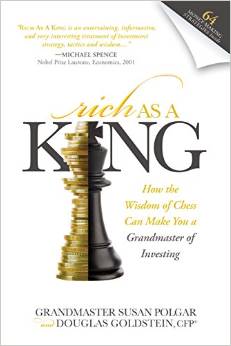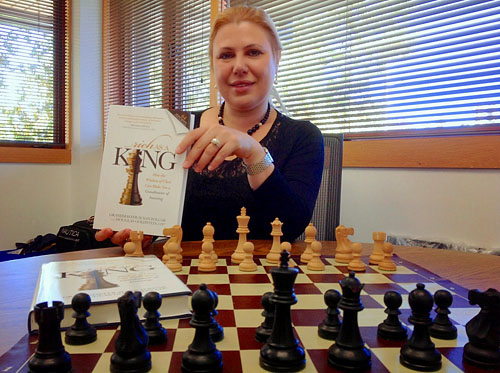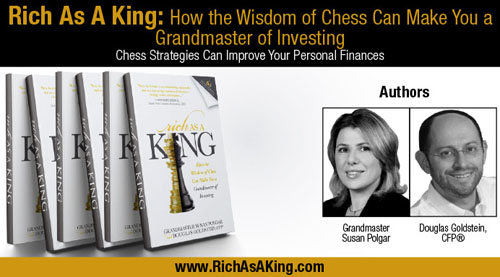“Rich as a King” teaches chess to invest!

As a business professor, I am able to see young adults mature as they begin to understand the elements financial responsibility. How many students have gone off to school only to be approached at orientation by banks offering a free water bottle to sign up for a debit card? Lots.
In the business school, we teach a variety of accounting and finance subjects, but many seem to miss the lessons on personal finance and accountability. I have read business books aimed at educating the consumer about personal financial management. I have even read a few that attempt to use chess as an overlying theme. Others have used Sun Tzu’s military philosophies in business strategy.
When Susan Polgar gave me a card promoting her new book, I took an interest. It was more of an attraction since I knew it would be on the subject of finance. Her co-author Douglas Goldstein is a financial consultant and combines his experience with Polgar’s prodigious chess insight.
In these books it is often seen that writers make bad cliches about how chess relates to business either because they don’t have the requisite chess skill or they don’t have the requisite business training to overlay the topics smoothly. This is not a book where you will learn the intricacies of the Sicilian Dragon, nor is it merely another book of the “Rich Dad, Poor Dad” fame. It is more like a primer dotted with countless examples of how successful investing also requires some chess intuition.

Susan Polgar’s “Rich as a King”
As I started to read, I realized that the duo would try to develop a division of labor and utilize their respective strengths. Of course it is always a challenge to make the subjects fit seamlessly, but of course one can draw lessons from the parallel examples. The book has four parts: Part A (Strategy), Part B (Tactics), Part C (Piece Movement) and Part D (Execution Plan). Part D provides 64 tips in how to execute a coherent investment strategy. I particularly enjoyed the strategy segment because it helps the reader to develop the psychology of an investor.
In the book, there were a number of examples given on investment concept using a chess analogy. For example, the idea of leveraging is something that chess players may understand well. If you have an investment that is steadily losing in the market do you divest or hold? What if the investment is gaining, do you sell while you’re ahead?
While sacrifices are usually executed for short-term gain (see diagram on left), how many times have we executed a sacrifice for a long-term gain (i.e., positional pressure)? As the game wears on, uncertainty lingers and time is ticking, it is tempting to try to win the material back instead of looking to increase the long-term advantage material down.
You have increased the value of the position, yet you are ready to recoup the material for an immediate return. Why sacrifice material if the only objective was to get it back immediately? The book gives the example of those cashing in a profitable position too soon and liquidating the advantage only to realize there was more potential down the road.
When you have to make a decision to sell, avoid letting the disposition effect blind you. Don’t jump to sell shares whose prices have increased while keeping those that have dropped in value.
The book gives a number of chess analogies, but of course not all of them will naturally occur to the non-chess reader. However, the reader has an option to bypass the chess examples. One of the related topics dealing with strategy is ensuring that you don’t get too confident when seizing an advantage… something we’ve all done. Then after losing the game, we say “I had a winning position.”
Perhaps the player became too blinded by the prospect of success. I have seen a number of documentaries on start-up businesses. Those documenting the e-Business companies in the late 90s were instructive (See “Startup.com“). These “dot-com” companies were riding high when the venture capital money flowed, yet the market crashed because there was simply too much optimism and not enough realism.
The tips offered for such strategic planning: reality, flexibility and resiliency. Those companies could have used this advice. These themes return throughout the book given that it represents the investment mindset. The idea of diversification is something we can understand in the age of chess technology. Some players place their hopes in a trusted, narrow opening repertoire. This will last a few times until the players learn your tendencies.
As with a diversified investment, it’s also important to diversify in terms of one’s chess opening choice and not put all one’s eggs in a single basket. Polgar mentioned one of her examples against Maia Chiburdanidze in which she unexpectedly played the English Opening. In fact, playing offbeat openings is in fashion and World Champion Magnus Carlsen is a big advocate.
One useful guide is determining when and where to place your money. A timeline is given for each decade of one’s adult life until retirement. The key to most of these concepts is to have a plan on specific goals. That is what we do as we work out way through variations over the chess board.
- Gather your information
- Define your goals
- Identify your barriers to achieving your goals
- Choose an asset allocation model
- Choose your investments
- Monitor your progress.
Part B is a short piece focused more on tactics. This gave more of an understanding of exactly what the instruments and tools needed to generate wealth. We already dealt with the mindset of strategic thinking. We all know that tactics are short-term actions that seek to make an immediate impact. In this chapter, they get into credit/debit cards and budgeting. I often tell my students about the dangers of the credit trap. The idea of swiping plastic cards is so painless that it does not burden one with the feeling of exhausting funds. That’s the whole point! Businesses want you to be able to spend more.
Although using cash is becoming infrequent, the book advocates using it more frequently to avoid the reliance on credit. In addition, the idea of organizing one’s expenses by analyzing receipts is always valuable. That way one can analyze patterns just as we are going over one of our games from the chess scoresheet. Despite the popularity of financial software, using the “envelope system” is very old-fashioned, but effective method to monitor expenses.

Part C deals primarily with stocks, bonds and mutual funds. It deals with the what, when, where, how and why. It idea of assessing risk and reward is key as each vehicle has a different value. One of the ideas behind and investment is to seek the greatest return for minimal or moderate risk. Of course that is not always possible, so one has to use diversification strategies.
About 30 years ago, there was an ad in Chess Life magazine looking for chess players who wanted a career in investing. It was thought that chess players possessed good analytical skills to make good decisions in the market. The “game theory” (no pun intended) may be the same in picking stocks as it is making a chess move from several choices. You have to weigh the risk and make the move that will provide the largest “gain” while considering an array of risk factors.
Part D tries to sum up all of the lessons of the previous parts with 64 strategies to help you to a successful investment plan. Each of these will have some merit and some can be executed immediately. Of course virtues like flexibility, patience, focus, timing and sacrifice are all concepts we know in chess. However, some of the concepts are a bit harder to grasp such as assessing risk. This seems to be the most difficult characteristic to master as a chess player. Imagine the added stress when you are making decisions with real money.
Here are ten of the 64 chess-friendly investment tips given in the book. Detailed explanations are given for each of the 64 tips.
#4. Accumulate small advantages.
#5. Make the most of your time.
#17. Risky playing will tire you out.
#18. Don’t attack a well-protected area.
#26. Playing flexibly vs. sticking to a strategy.
#30. Trade off bad pieces immediately.
#34. If you blunder, don’t give up fighting.
#38. Get a free piece.
#50. Take your money out of the bank!
#59. The backup plan you need now
Synopsis: This book had some interesting concepts and of course the chess stories were fun to read. The authors decided to create mini-stories to reinforce the points and of course there is a risk in this. Because a chess player will be familiar with Susan Polgar, they will enjoy some of her personal stories.
about losing a pawn on the queen’s side.”
~Garry Kasparov
The book is an interesting read and I would recommend Part B which provides some quick tips. In Chapter Five there is a segment on budgeting. How many of us have actual budgets that we keep meticulously? Pages 114-115 poses some introspective questions to help you to prioritize cost-saving methods. This is one that we can take heed to…
Can you give yourself a time limit in the store? Put a half-hour on your parking meter and you won’t have time to browse leisurely.
I love the idea of limiting the time because we certainly go into stores with five items on the list and come out with 20. You’ll also need a cell phone alert to remind you of the time or your flag will fall and you’ll be making a financial outlay in the name of a parking ticket! 😐
One improvement could have been to provide more consumer examples of financial disaster and subsequent recovery using the lessons of the book. This would make the concepts compelling. People who recover from making financial blunders (i.e., $100,000 credit card debt) have the most compelling stories to tell and they provide a good reference point for those who may believe they are alone in this struggle for financial health. Nevertheless, it is a good primer for understanding the elements that are important in making sound investment choices.

Link: https://www.amazon.com/
